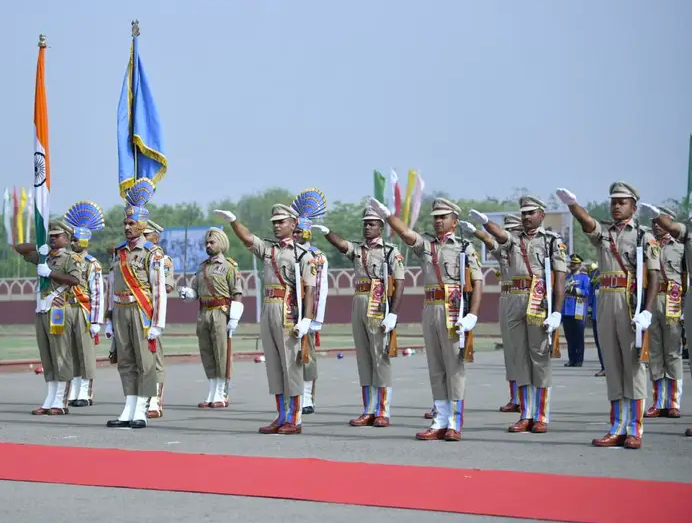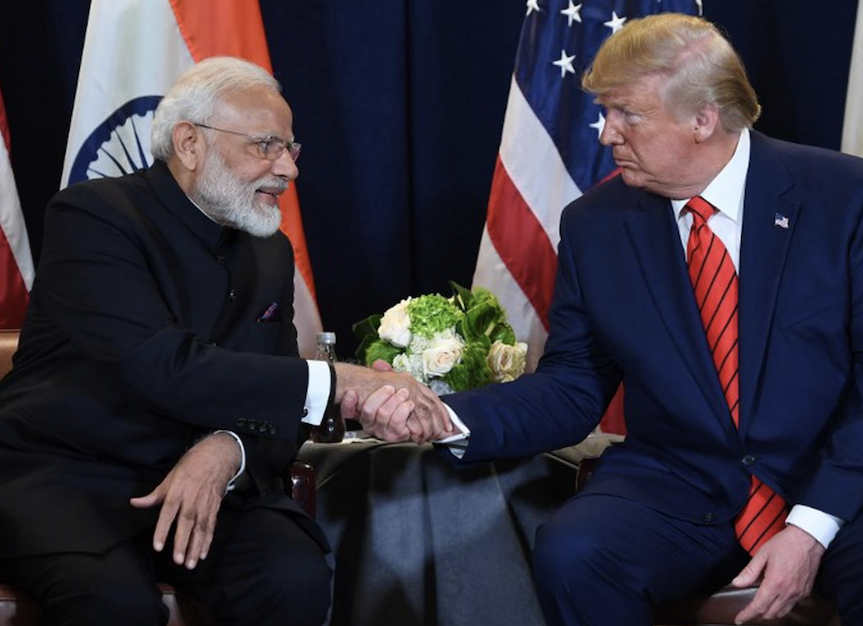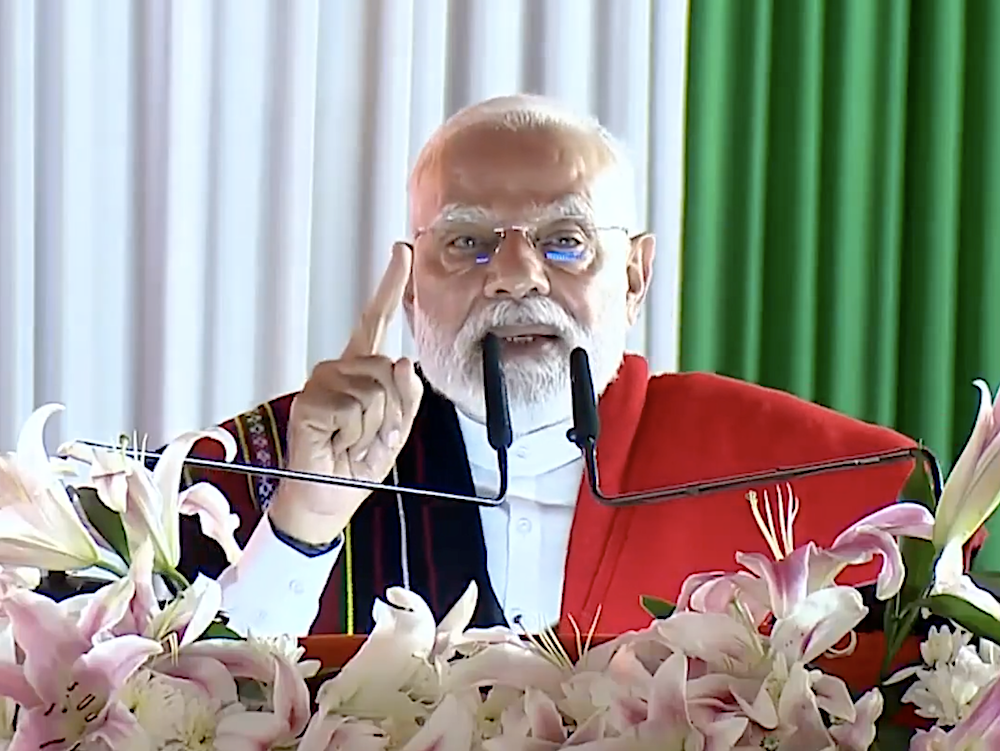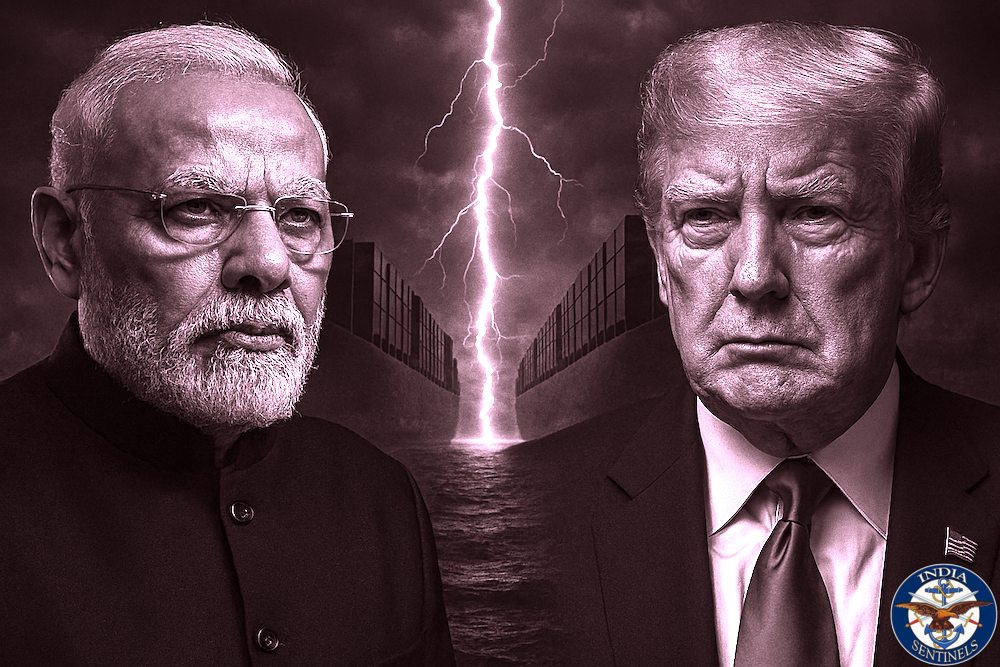 Pakistan Army chief Asim Munir (L) receiving the field marshal’s baton after being promoted to the rank from the country’s president, Asif Ali Zardari, and prime minister, Shehbaz Sharif (R).
Pakistan Army chief Asim Munir (L) receiving the field marshal’s baton after being promoted to the rank from the country’s president, Asif Ali Zardari, and prime minister, Shehbaz Sharif (R).
Pakistan’s recent elevation of its army chief, General Syed Asim Munir Ahmed Shah, to the rank of field marshal represents far more than ceremonial honour. It signals a fundamental shift in regional military dynamics that India must urgently address.
Having witnessed Pakistan’s military doctrine evolve over decades and analysed China’s growing influence in South Asian security affairs, this author believes the promotion carries profound implications for India’s national security. The timing, context, and strategic messaging behind Munir’s elevation reveal calculated positioning for future confrontation – one that India must prepare for with unprecedented seriousness.
The Balakot Legacy
The February 26, 2019, Balakot incident marked a watershed moment in India-Pakistan military relations, which established new paradigms for cross-border operations while revealing critical vulnerabilities on both sides.
Following the Pulwama attack that killed 40 CRPF personnel, India’s airstrikes on terror camps in Balakot, Khyber-Pakhtunkhwa, codenamed Operation Bandar, represented significant escalation in response doctrine. However, Pakistan’s retaliatory Operation Swift Retort, on February 27, exposed fundamental weaknesses in India’s electronic-warfare capabilities and air-defence coordination that continue to have strategic implications to this day.
Read also: Was Op Sindoor ceasefire premature? Analysing its strategic impact
Pakistan’s ability to conduct what they termed their “first large-scale air operations involving many modern assets” during Swift Retort demonstrated sophisticated network-enabled warfare capabilities. The operation successfully integrated multiple platforms, including JF-17s, F-16s, Mirage III/5-based aircraft, and – crucially, electronic-warfare systems that proved decisive in the engagement.
Most significantly, Pakistan achieved its tactical objectives while exploiting India’s electronic-warfare vulnerabilities – a major factor among others that led to the downing of an Indian MiG-21 and the capture of Wing Commander Abhinandan Varthaman.
The incident also revealed catastrophic coordination failures within Indian air-defence systems, which culminated in the friendly fire incident that destroyed an Indian Mi-17 helicopter, killing all six personnel on board and a civilian on ground. The Indian Air Force later acknowledged this “mistake” and pledged to prevent such incidents, but the underlying systemic issues that enabled such failure remain concerning.
These operational shortcomings provided Pakistan with valuable intelligence about India’s air-defence gaps and electronic warfare limitations – knowledge that has undoubtedly went into their subsequent military planning.
Read also: How India checkmated Pakistan COAS Gen Munir’s dream project
Pakistan’s Learning Curve
Pakistan’s evolution following the 2019 engagement has been substantial. The successful demonstration of their network-centric warfare capabilities during Swift Retort revealed that Pakistan had achieved near-parity with India in certain technological domains, particularly in electronic warfare and integrated air operations.
Air Marshal M Matheswaran’s post-Balakot analysis [archived link] highlighted how “the Pakistani use of F-16 Block 52 in the retaliatory strike had kept the frontline fighters of the IAF at bay,” which underscored the technological gap that enabled Pakistan’s tactical success.
Pakistan’s Capabilities Now
The recent Operation Sindoor, launched by India in response to the April 22 Pahalgam attack that killed 28 tourists, provided Pakistan with another opportunity to demonstrate its evolved military capabilities. India’s air and missile strikes targeted nine sites across Pakistan and Pakistan-occupied Kashmir, which was a significant escalation in response doctrine.
However, Pakistan’s handling of this air operation suggests they have built upon lessons learned from the 2019 engagement to enhance their defensive and retaliatory capabilities, especially when it comes to their air force.
The timing of Munir’s promotion to field marshal in the immediate aftermath of Operation Sindoor is particularly significant. This elevation came despite what experts characterize as “military setbacks against India, including Operation Sindoor and strikes on Pakistani bases.”
Read also: Understanding Pakistan’s ‘deep state’ and its threat to world
The promotion’s timing suggests a deliberate message: Pakistan views its handling of the Indian strikes as sufficient to warrant the highest military honour, regardless of external perceptions of tactical outcomes. What remains unstated is that it represents a strategy for the future, which is likely to unfold soon.
Pakistan’s claimed success in “shooting down multiple Indian military planes” during Operation Sindoor, while unverified, demonstrates their confidence in engaging Indian air assets. This assertiveness reflects institutional knowledge gained from Swift Retort and suggests Pakistan believes it has developed effective countermeasures to Indian air operations.
The Pakistani military’s public narrative around Operation Sindoor emphasizes their multi-domain warfighting capabilities as “superior” to India’s, which indicates a strategic effort to establish military credibility for future confrontations.
The China Factor
Pakistan’s military evolution cannot be understood without acknowledging China’s comprehensive support across multiple domains. The China-Pakistan strategic partnership has evolved beyond traditional weapons sales to encompass technology transfer, joint development programmes, and tactical knowledge sharing that significantly enhances Pakistan’s capabilities against India.
Read also: China’s covert military support to Pakistan emerges as major concern for India
China’s motivation extends beyond supporting an ally against a common adversary – it seeks to test its military technologies and doctrines against western systems, which along with Russian systems, form the backbone of India’s defence arsenal.
Chinese electronic-warfare systems, integrated into Pakistan’s air-defence network, have likely contributed to their improved performance against Indian air operations. The sophisticated coordination demonstrated during Operation Bunyan-ul-Marsoos (solid wall of lead) – their military reaction to Operation Sindoor – suggests Chinese technical advisers and systems played a key role in Pakistan’s network-centric warfare capabilities.
China’s provision of advanced radar systems, electronic countermeasures, data-link technologies, and military satellite communications and real-time battlefield imagery has enabled Pakistan to achieve parity with or even exceed India in specific operational domains.
Strategic Knowledge Transfer
The strategic implications extend beyond hardware provision. China’s military modernization experience, gained through decades of studying western military operations and developing countermeasures, directly benefits Pakistan through knowledge transfer and joint training programmes, which Beijing and Islamabad had been conducting for decades.
Read also: India must move earnestly and quickly to settle border dispute with China
Chinese insights into defeating western air-defence systems, electronic warfare techniques, and multi-domain operations provide Pakistan with tactical advantages that extend far beyond their indigenous capabilities.
Furthermore, China’s investment in Pakistan’s military infrastructure through the China-Pakistan Economic Corridor (CPEC) includes dual-use facilities that enhance Pakistan’s military readiness. Communications networks, logistics hubs, and technical facilities developed under the CPEC project provide Pakistan with improved command & control capabilities that directly support military operations against India.
Munir’s Strategic Positioning
Asim Munir’s background as former head of Pakistani military’s Inter-Services Intelligence (ISI) adds particular significance to his elevation to field marshal. The ISI’s role in Pakistan’s strategic planning, particularly regarding Kashmir and operations against India, means Munir brings institutional knowledge and networks that extend beyond conventional military planning. It is the ISI that motivates, funds, trains, and sends militants and terrorists to carry out attacks in India.
His experience in intelligence operations provides him with detailed understanding of India’s vulnerabilities and strategic decision-making processes.
Munir’s recent public statement regarding Kashmir as Pakistan’s “jugular vein” demonstrate his commitment to an assertive policy against India. His positioning as only the second field marshal in Pakistan’s history creates symbolic pressure to achieve military success that justifies this rare honour. Therefore, this promotion effectively makes him accountable for delivering strategic victories that validate Pakistan’s investment in his leadership.
Read also: Pahalgam is a wake-up call to shed myopic view on J&K proxy war
Historical Context
The historical context of Pakistan’s military defeats, particularly the humiliating defeat in the 1971 war that led to Bangladesh’s independence, creates additional psychological pressure for vindication. Munir’s elevation occurs at a time when Pakistan faces economic challenges that traditionally push military leadership toward external confrontation to unify domestic opinion.
Therefore, keeping this in mind, his promotion despite recent tactical setbacks reflects confidence in future operational planning. It suggests preparation for significant military action rather than defensive posturing.
Most commentators and “experts” in our country have seemingly missed this critical point. One such Indian “expert” smugly noted: “The field marshal rank is usually conferred after a military victory. This may be the first time it has been awarded after a defeat – it seems intended to mask that defeat.” However, this “analysis” and other similar ones may underestimate Pakistan’s strategic calculation that Munir’s promotion positions him for future success rather than compensating for past failures.
Read also: India must consolidate its western front to tame Pakistan
India’s Strategic Imperatives
India’s response to Pakistan’s enhanced capabilities and aggressive positioning must acknowledge the fundamental shift in regional military balance. The combination of Chinese technological support, Pakistan’s learning from recent engagements, and Munir’s strategic positioning creates a threat environment that requires comprehensive Indian military modernization.
Traditional approaches to India-Pakistan military competition are insufficient given the multi-domain nature of modern warfare and China’s indirect but substantial involvement.
India’s electronic warfare capabilities require immediate enhancement to counter Pakistan’s demonstrated advantages in this domain. The 2019 Swift Retort and recent Operation Sindoor both highlighted Indian vulnerabilities in electronic countermeasures and network defence that Pakistan has successfully exploited.
Chinese electronic-warfare technology, which is very likely integrated into Pakistan’s systems, means India faces capabilities that extend beyond Pakistan’s indigenous development.
India’s air-defence coordination, exposed as critically flawed due to lack of foolproof networked environment during the friendly fire incident of 2019, remains a fundamental vulnerability that Pakistan will certainly target in future operations. The deep institutional problems require comprehensive reform rather than incremental improvements.
Read also: Robust HUMINT network is the key to defeat militancy in J&K
Intelligence Adaptation
Another key area is India’s intelligence gathering and analysis capabilities. It must adapt to the reality that Pakistan now receives comprehensive Chinese support in planning operations against India. Traditional intelligence methods is already proving insufficient against an adversary that benefits from Chinese strategic planning expertise and technological capabilities.
India’s intelligence community must develop new methodologies for assessing Pakistani capabilities that account for Chinese support. This is an absolute must.
Pakistan’s strategic calculation likely assumes that Chinese support provides sufficient capability enhancement to achieve tactical victories that could fundamentally alter regional balance. India must prepare for this possibility by developing capabilities that can effectively counter Chinese technology and strategic planning working through Pakistani forces.
Read also: Decoding India’s strategic messaging amid N-speculation surrounding Pak’s Kirana Hills
The Bottomline
Field Marshal Asim Munir’s elevation represents Pakistan’s confidence in their enhanced capabilities and strategic positioning for future confrontation with India. The combination of lessons learned from recent engagements, comprehensive Chinese support, and Munir’s personal commitment to achieving strategic victories creates a threat environment that India cannot address through traditional responses.
The promotion signals Pakistan’s belief that they possess sufficient capabilities to achieve tactical victories that could fundamentally alter regional strategic balance in the not-so-distant future. Now that India has declared a new anti-terror doctrine, which effectively lowers the threshold for an all-out war between the two nuclear-armed neighbours, it would be easier for Munir to lay a trap for India to enter a conflict where he can have his way with Beijing’s help.
Therefore, India’s response must acknowledge this reality and do what is required to be done urgently. The time for incremental improvements has passed – India faces a strategic competitor that has achieved near-parity or exceeded it in specific domains and possesses external hi-tech support from China that significantly enhances their capabilities.
Field Marshal Munir’s promotion should serve as a wake-up call for Indian strategic planners to prepare for confrontation with an adversary that has evolved significantly. The question is not whether Pakistan will test their enhanced capabilities against India, but when – and how India will be prepared to respond effectively to this challenge.
Disclaimer: The views expressed in the article are the author’s own and don’t necessarily reflect the views of India Sentinels.
Follow us on social media for quick updates, new photos, videos, and more.
Twitter: https://twitter.com/indiasentinels
Facebook: https://facebook.com/indiasentinels
Instagram: https://instagram.com/indiasentinels
YouTube: https://youtube.com/indiasentinels
© India Sentinels 2025-26










